How to make a presentation longer without losing your audience?

"The secret to a great presentation is to deliver great content, keep it simple, and have fun." - Richard Branson
Have you ever found yourself in a presentation that seemed to rush through critical details, leaving you wanting more? Or perhaps you’ve endured a presentation that seemed to drag on without purpose, making it hard to stay focused. Striking the perfect balance between providing comprehensive information and keeping your audience engaged is an art.
In a world where attention spans are limited, extending your presentation’s length without sacrificing your audience’s interest is a valuable skill. But how can you achieve this? How can you make your presentation longer while keeping it engaging and dynamic?
This blog will explore the ideal length for a captivating business presentation, identify situations where a longer presentation is necessary, and provide strategies to enhance your presentations' length and engagement.
What is the ideal length for a captivating business presentation?
Why do some presentations leave you on the edge of your seat while others make you glance at the clock every few minutes? The secret often lies in the length. The right duration can transform a presentation from a mundane monologue into an engaging dialogue. But what is the ideal length for a business presentation that captivates, informs, and leaves a lasting impact? These points will give you some clarity:
The sweet spot
Although there's no definitive answer, many experts agree that a business presentation lasting between 15 to 30 minutes is typically the most effective. This timeframe allows you to cover your essential points thoroughly without losing your audience's attention.
Consider the example of TED Talks, renowned for their impactful presentations. These talks are intentionally limited to 18 minutes, balancing brevity with depth. This length forces speakers to distill their message to its most powerful form, ensuring every minute counts.
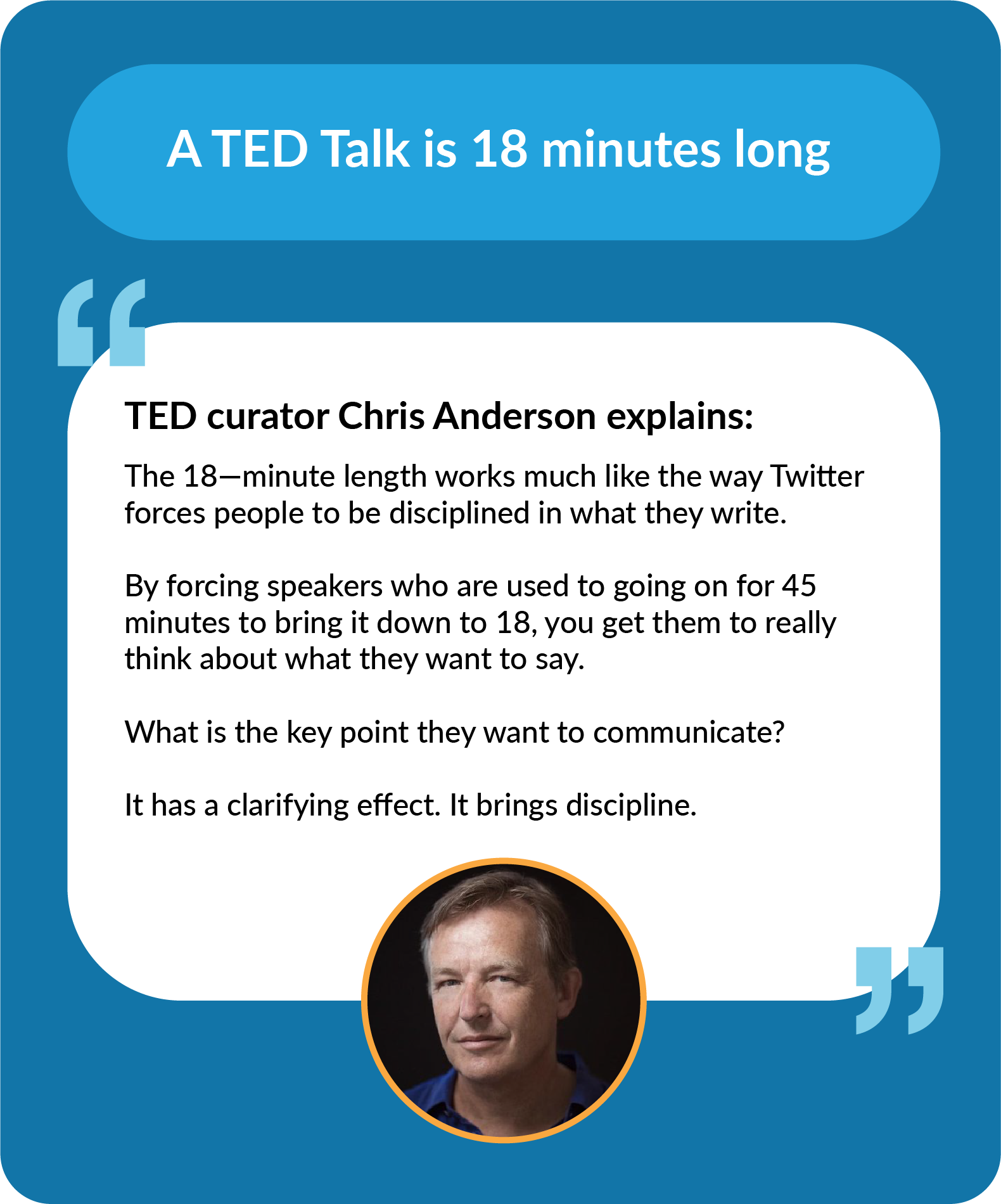
Facts to consider
A) Audience profile
Think about WHO you're presenting to. Busy executives have packed schedules and appreciate brief, high-impact presentations that get straight to the point. In contrast, technical teams might prefer a more detailed, longer presentation that delves into specifics. For instance, when presenting to executives, aim for succinct, high-level overviews. On the other hand, when addressing technical teams, be prepared for a deeper dive with detailed explanations and thorough analyses.
B) Content complexity
Reflect on the complexity of your topic. Are you presenting a straightforward quarterly update or unveiling a new, sophisticated technology? The depth of your subject matter can dictate the length of your presentation. Simple topics can often be communicated effectively in 10-15 minutes, while complex topics may require 30 minutes or more to ensure comprehensive understanding.
C) Purpose of the presentation
Consider the objective of your presentation. Whether your goal is to inform, persuade, or train will significantly influence how long you should speak. Informative presentations should focus on delivering key facts clearly and efficiently. Persuasive presentations need more time to build an argument, present evidence, and counter objections. Training sessions typically require longer durations to incorporate interactive elements and hands-on practice, ensuring participants fully grasp and retain the information.
The dilution effect
An essential concept to bear in mind is the dilution effect, as highlighted by Niro Sivanathan in his TED Talk. Adding more arguments or points to your presentation doesn't necessarily strengthen your case. In fact, including weaker or less relevant points can dilute the impact of your stronger arguments, ultimately reducing the overall effectiveness of your presentation. This underscores the importance of focusing on quality over quantity when preparing your content.
The 10-20-30 rule
Guy Kawasaki’s 10-20-30 rule for PowerPoint presentations offers a practical guideline for creating effective presentations. According to this rule, a presentation should have 10 slides, last no more than 20 minutes, and use a 30-point font for the text. This approach helps to keep your presentation focused, concise, and visually accessible, enhancing engagement and comprehension.
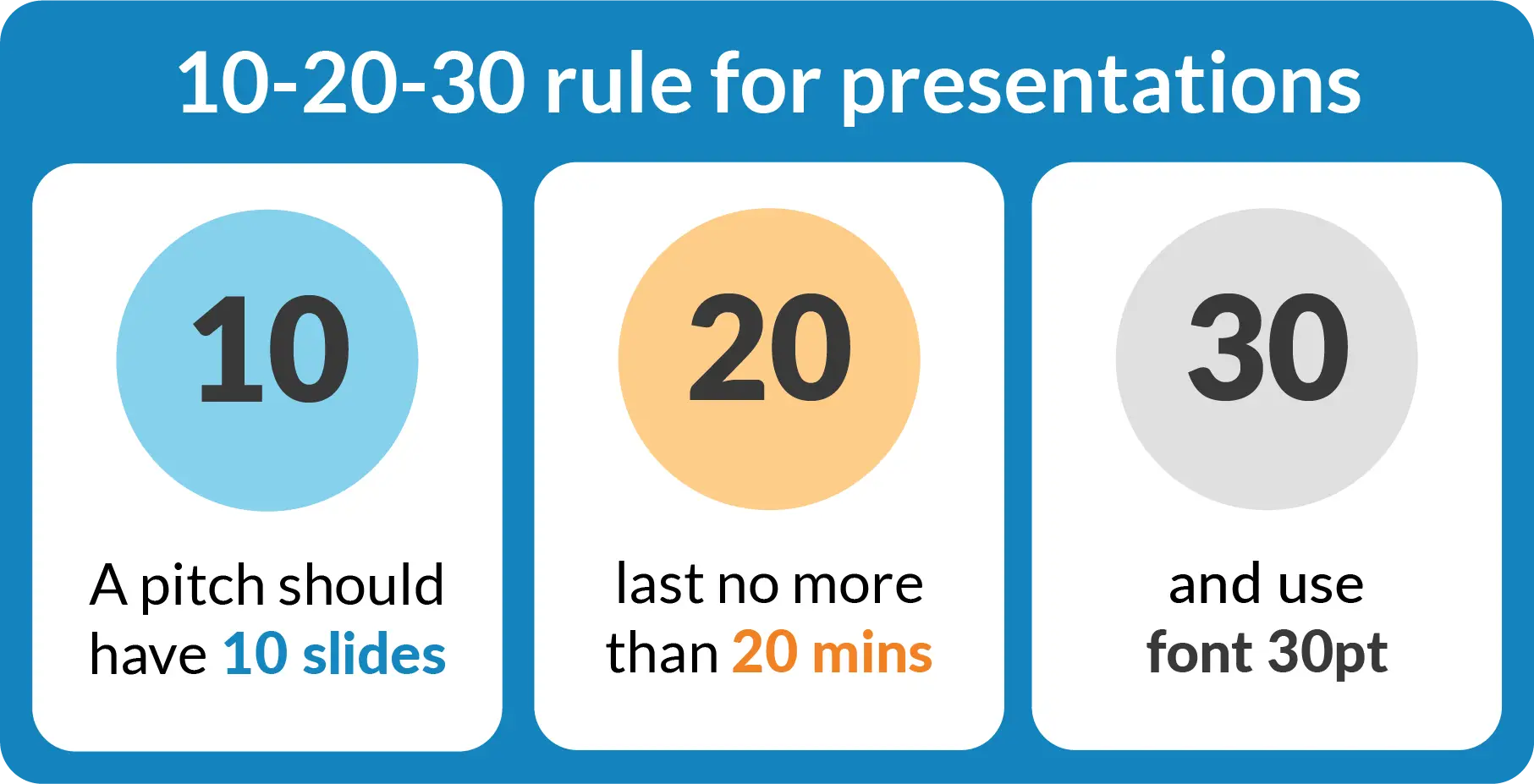
Situations that may need a longer presentation
While shorter presentations are often preferred for their conciseness, there are critical scenarios where a longer presentation is both necessary and beneficial. Understanding these situations can help you deliver more impactful and effective presentations and keep your audience engaged throughout.
Diving into complex topics
Complex subjects such as new technologies, scientific discoveries, or advanced business strategies require thorough exploration. To fully embrace the topic and ensure your audience comprehends the intricacies, you need a lengthy presentation. This allows you to cover all the necessary nuances and details, providing your audience with a comprehensive understanding and helping them grasp complex information effectively.
Policy and legislative matters
When discussing policy changes, legislative updates, or regulatory compliance, the details matter. These topics involve intricate regulations and numerous implications, necessitating a detailed presentation to dissect each component carefully. This extended time helps clarify uncertainties, address potential concerns comprehensively, and ensure your audience is knowledgeable about the topic.
In-depth training sessions
Training sessions, particularly those involving new software, processes, or methodologies, require more time. To make your presentation longer and more effective, include detailed, step-by-step guidance, hands-on practice, and ample opportunities for questions and troubleshooting. This thorough approach ensures participants gain practical and actionable knowledge, making the training meaningful and helping your audience fully grasp the material.
Strategic planning and decision-making
Strategic meetings or board presentations that discuss long-term business plans, major organizational changes, or significant investments demand thorough analysis and detailed discussion. In these cases, a long presentation is justified as it allows for comprehensive coverage of all aspects, from market analysis and financial projections to risk assessments and implementation strategies. This detailed approach supports informed decision-making and strategic planning.
Comprehensive project overviews
Project kickoffs and reviews are scenarios where a longer presentation is warranted. At the start of a project, it's essential to set clear expectations, outline objectives, and detail the roles and responsibilities of each team member. During mid-project or end-of-project reviews, lengthening your presentation ensures thorough discussion of progress, identification of challenges, and strategizing next steps. This depth ensures that all team members are aligned and the project stays on track.
Academic and technical conferences
Presentations at academic and technical conferences often require more time to cover research findings, methodologies, and implications comprehensively. A longer presentation ensures that you can delve deeply into your material, helping the audience understand and appreciate the significance of your work. This thorough coverage is crucial for conveying complex research and technical information.
Crisis management and contingency planning
In situations involving crisis management or contingency planning, details are critical. Extending your presentation to cover all possible scenarios, responses, and action plans ensures that stakeholders are fully prepared for any eventuality. A longer presentation in these scenarios supports effective crisis management and contingency planning, providing all necessary details and strategies.
Legislative and regulatory updates
Policy and legislative matters often involve complex regulations and numerous implications that need careful explanation. A longer presentation helps in dissecting each component, clarifying uncertainties, and addressing potential concerns comprehensively. This detailed approach ensures that your audience understands the legislative updates and their potential impact fully.
Remember, while brevity is often valued, certain situations call for more extended presentations. By understanding when a longer presentation is justified, you can ensure that your audience receives the detailed and comprehensive information they need. This approach enhances the effectiveness of your communication and supports informed decision-making, helping to captivate your audience and keep them engaged throughout the presentation.
How to make your business presentation longer and more engaging
Extending the length of your presentation without losing your audience’s interest can be tricky. However, with the right strategies, you can create a captivating and effective presentation that maintains engagement throughout. Here are some of the best ways to achieve this balance.
Structure your presentation effectively
When it comes to giving a successful presentation, the structure is paramount. A well-structured presentation not only helps in conveying your message clearly but also keeps your audience engaged and interested from start to finish.
1) Start with a compelling introduction
The introduction of your presentation is your first chance to grab the audience's attention, so make it count. Instead of jumping straight into the content, start with something that will intrigue your audience. For instance, you could open with a relevant quote that resonates with the core message of your presentation. Alternatively, you might use a surprising statistic that highlights the significance of your topic. Another powerful approach is to tell a short, engaging story that sets the stage for what you’re about to discuss.
Pro-tip: According to a study by Microsoft, you have about 8 seconds to capture your audience’s attention, so make sure your introduction is impactful and to the point.
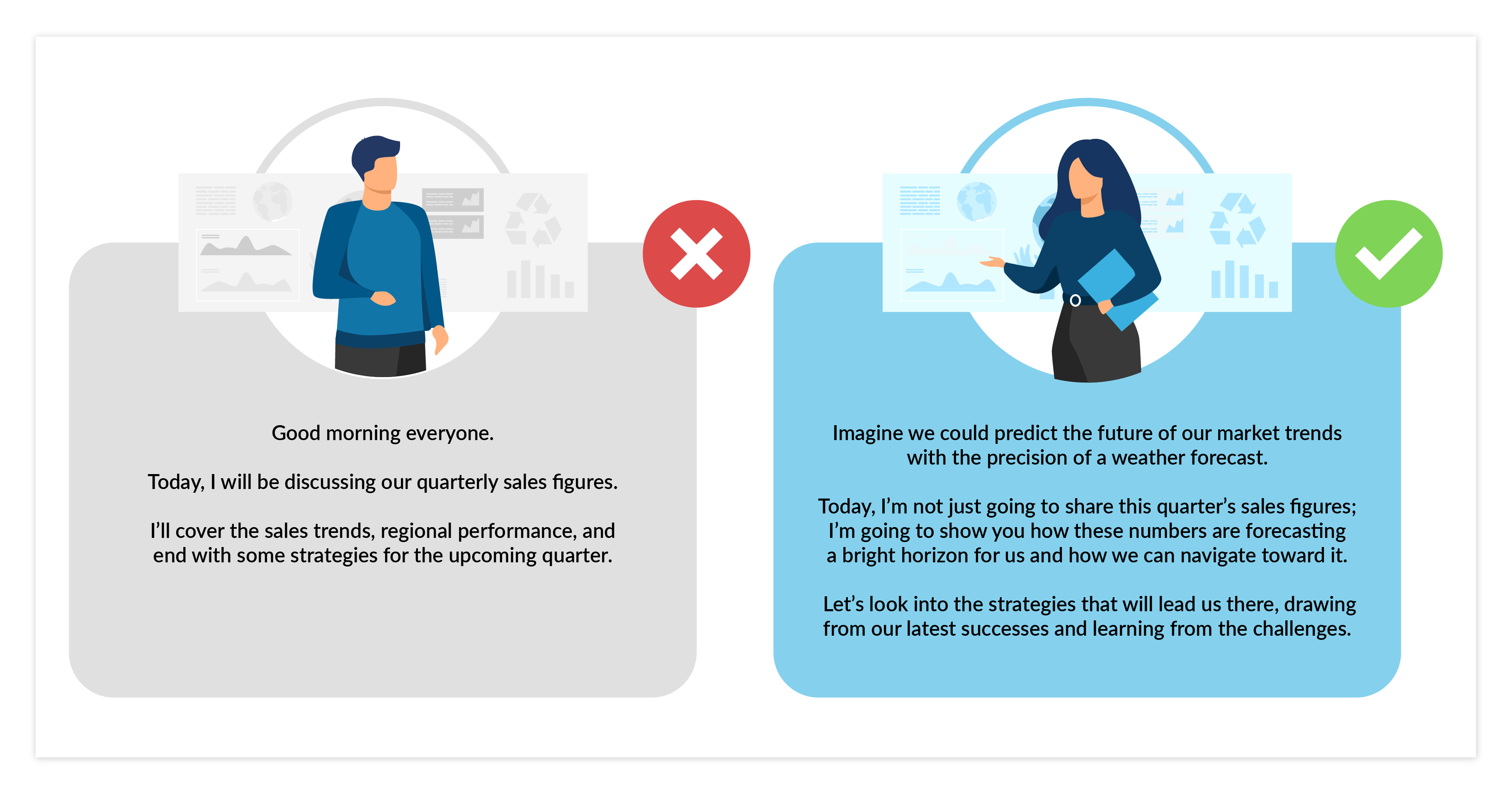
2) Outline your key points
Once you’ve captivated your audience with a compelling introduction, giving them a roadmap of what to expect is essential. Outlining your key points at the beginning of your presentation helps your audience to understand the structure and flow of your talk. This can be as simple as briefly mentioning the main topics you will cover. For example, if you’re giving a presentation on effective leadership, you might outline that you will discuss communication, decision-making, and team-building as your main points.
Pro-tip: Research from the University of Amsterdam found that presentations with a clear structure are 40% more likely to be remembered by the audience compared to those without a clear structure.
Deepen your content
1) Add detailed examples and case studies
Enhancing your content with detailed examples and case studies can significantly increase its impact. Real-world applications of your ideas make your content more relatable and provide tangible proof of your concepts. For instance, consider a company that implemented a new marketing strategy. Instead of just stating that the strategy was successful, delve into the specifics. Explain how the company identified a target audience, created tailored content, and tracked the campaign’s success. This detailed narrative not only illustrates the strategy's effectiveness but also offers readers a clear blueprint they can adapt to their own needs.
2) Incorporate data and statistics
Data and statistics are powerful tools for backing up your arguments. They provide concrete evidence that supports your claims and can significantly enhance your credibility. Visual aids like graphs and charts can make complex information more digestible and visually appealing.
Pro-tip: When using data, ensure it is sourced from reputable studies or surveys. Incorporating recent and relevant statistics will keep your content current and authoritative.
3) Include quotes and expert opinions
Incorporating quotes from industry experts can add substantial credibility to your presentation. Expert opinions not only reinforce your points but also provide additional perspectives. For example, if you’re discussing the future of artificial intelligence, quoting a renowned AI researcher can lend weight to your arguments. Consider a quote like,
“According to Dr. Andrew Ng, AI is the new electricity and will transform every industry in the next decade.”
This not only supports your view but also aligns it with respected authorities in the field.
Enhancing engagement with visuals
1) Employ high-quality images and graphics
Visuals are a powerful tool in increasing audience engagement. When used effectively, they can illustrate your points clearly and make your presentation more memorable. High-quality images, infographics, and diagrams can break up text-heavy slides, making the content easier to digest. For instance, using relevant images can evoke emotions and connect with your audience on a deeper level. Infographics, on the other hand, can simplify complex information and highlight key data points. A well-designed infographic can make statistics more engaging and easier to understand.
Pro-tip: Always ensure your visuals are relevant and support the message you are conveying. High-resolution images and professionally designed graphics can enhance your credibility and make your presentation look polished.
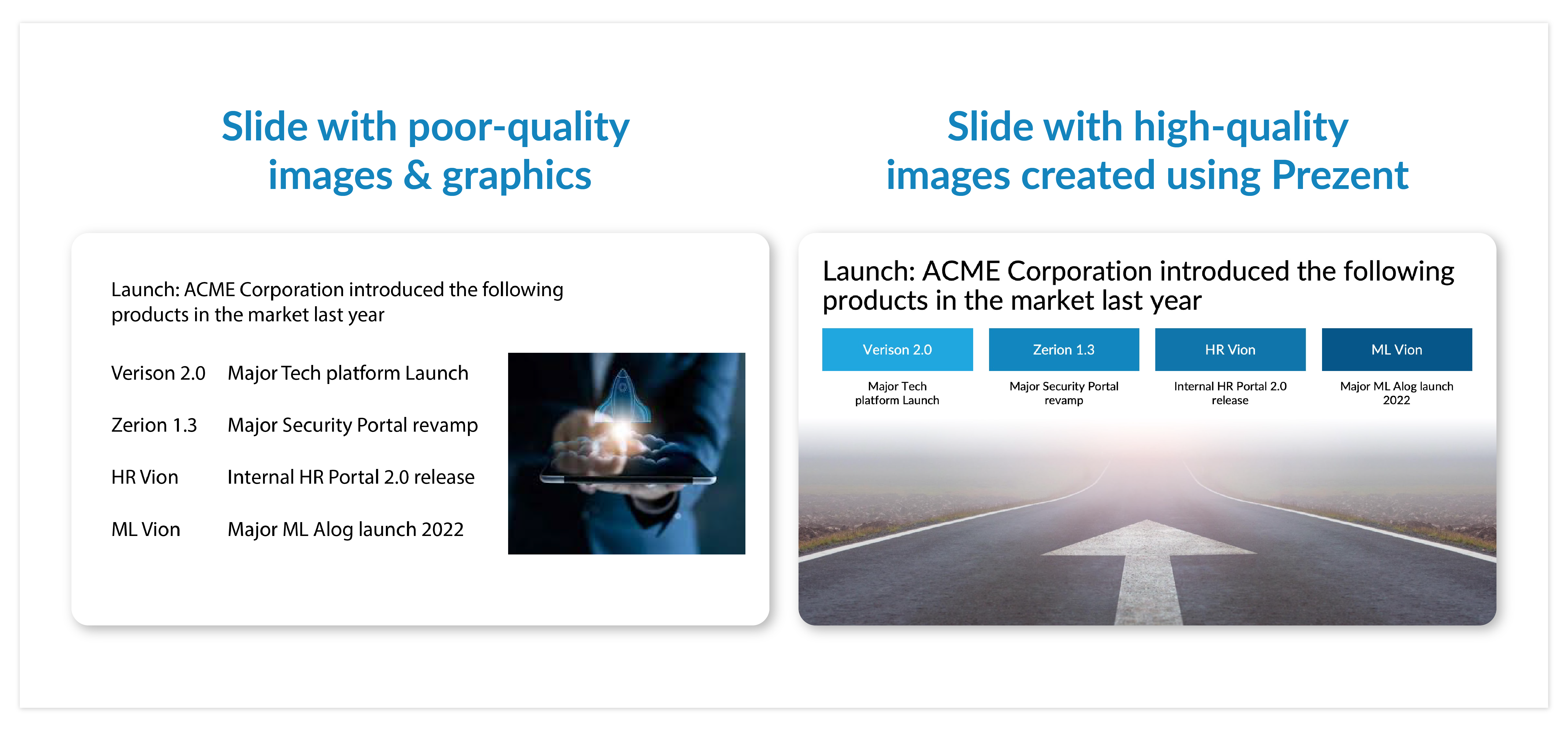
2) Utilize videos and animations
Incorporating videos and animations can take your presentation to the next level. Videos can capture attention quickly and explain complex ideas more effectively than text or static images. Short clips related to your topic can add variety to your presentation and keep your audience interested. For example, a 30-second video demonstrating a product feature can be far more engaging than a slide full of bullet points.
Animations, when used sparingly, can also enhance your presentation by highlighting important information and guiding the audience's focus. Animated transitions between slides can keep the flow of your presentation smooth and dynamic.
Pro-tip: Use videos and animations to supplement your message, not overshadow it. Keep videos short and to the point, and ensure animations are smooth and not distracting.
Interactive elements
To create a memorable and impactful experience, incorporating interactive elements is essential. By fostering participation and involving your audience, you can transform a standard presentation into a dynamic and engaging event. Here’s how you can achieve this:
1) Ask questions and encourage participation
One of the most effective ways to engage your audience is by asking questions. This not only encourages participation but also keeps the audience attentive and invested in your presentation. For example, start with a thought-provoking question related to your topic. This can be something as simple as, "What challenges have you faced with this issue?" or "How do you think this can be improved?"
Pro-tip: Pause after asking a question to allow your audience time to think and respond. This creates a conversational atmosphere and makes your presentation more interactive.
2) Incorporate audience activities
Incorporating activities that involve the audience can significantly enhance their learning experience and retention of information. Activities such as small group discussions, role-playing, or hands-on exercises are excellent ways to achieve this. These activities break the monotony of a lecture-style presentation and encourage active participation.
Pro-tip: Plan activities that are directly related to your key messages. For instance, if your presentation is about teamwork, you can include a group exercise that requires collaboration and problem-solving.
Storytelling techniques
Crafting an engaging presentation is an art form, and storytelling is at its heart. By employing effective storytelling techniques, you can captivate your audience, making your message memorable and impactful.
1) Use a narrative arc
Think of your presentation as a journey, guiding your audience from a starting point to a destination. A clear narrative arc is essential for this journey. It involves setting up a problem, exploring potential solutions, and concluding with a compelling resolution.
Example: Imagine you’re presenting on the importance of cybersecurity. Start by highlighting a real-world data breach that caused significant damage (the problem). Then, discuss various cybersecurity measures that could have prevented the breach (potential solutions). Finally, end with a success story of a company that implemented these measures and avoided a major threat (the resolution).
2) Personal anecdotes
Sharing personal anecdotes can make your presentation more relatable and engaging. Personal stories humanize your presentation, creating a connection with your audience. They see you as a person who has experienced similar challenges and successes, not just as a speaker.
Pro-tip: Ensure your anecdotes are relevant to your topic and audience. While a funny story from your childhood might be entertaining, it’s essential that it ties back to the main message of your presentation.
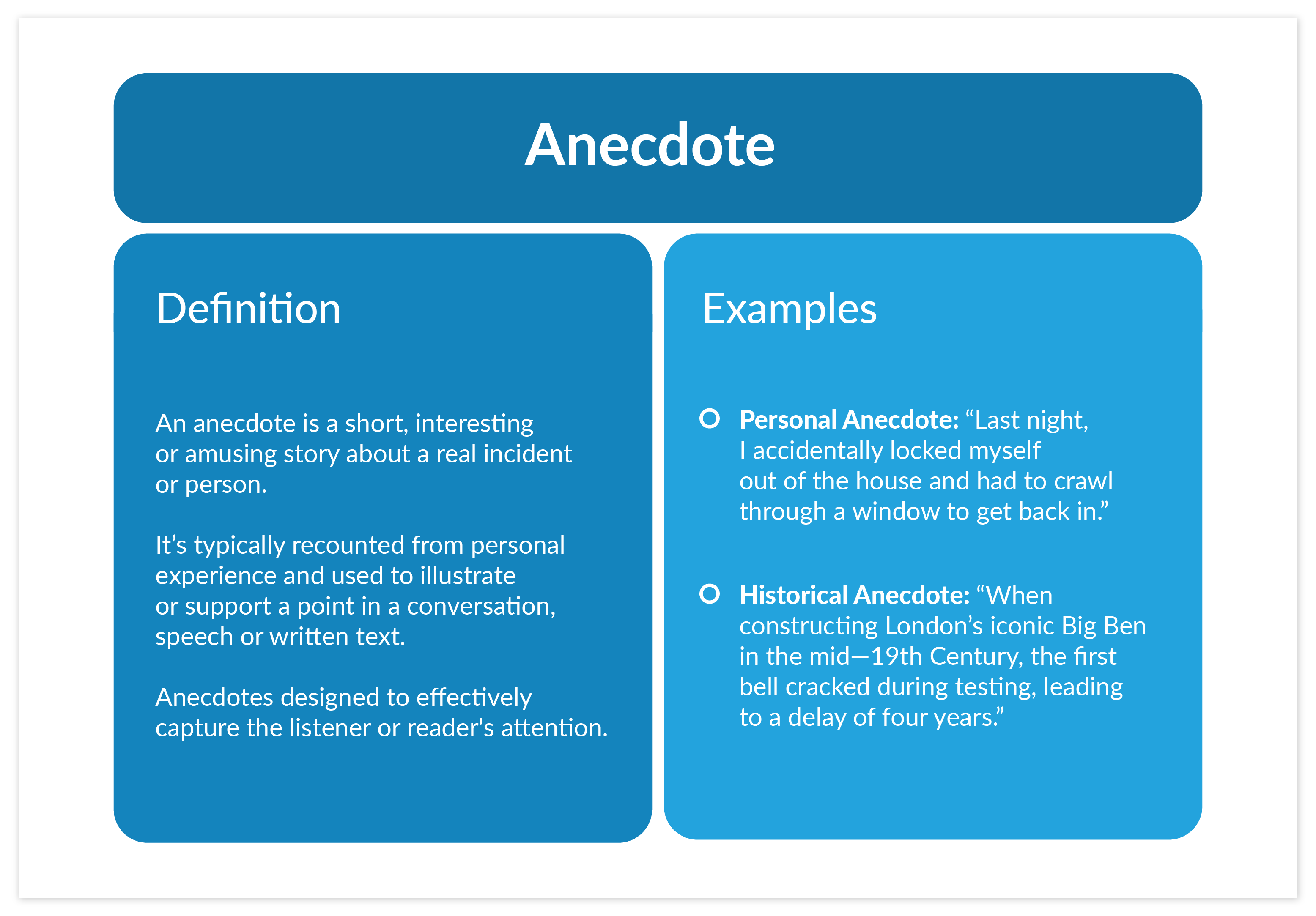
Mastering pacing and delivery
1) Engage through varied speaking pace
One of the most effective ways to keep your audience engaged is by varying your speaking pace. Imagine you’re telling a story: you wouldn't speak in the same tone and speed throughout, right? Slowing down when you hit a critical point emphasizes its importance and allows your listeners to absorb and reflect on what you’ve said. Conversely, picking up the pace for less critical information can keep the momentum going and prevent your audience from losing interest.
Pro-tip: Practice your speech with different paces. Record yourself and play it back to notice where changes in speed feel natural and where they can enhance the message.
2) Use pauses to your advantage
Strategic pauses are powerful tools in any speaker's arsenal. A well-timed pause can emphasize a key point, giving your audience a moment to digest and reflect. It can also create anticipation, making your presentation more dynamic and engaging. Pauses are particularly effective after posing a thought-provoking question or before revealing crucial information.
Pro-tip: Incorporate a pause after making a significant statement or asking a rhetorical question. This not only highlights the importance of the point but also allows the audience to process and internalize it.
Practice and refine your presentation
1) Rehearse your presentation
Rehearsing your presentation is not just a step to check off your list; it’s a crucial part of ensuring a polished and confident delivery. Practice your presentation multiple times in front of a mirror, record yourself, or present to a trusted friend. Each rehearsal will help you become more familiar with your content, allowing you to focus on your delivery rather than just remembering what to say.
Pro-tip: Treat your rehearsal like the real thing. Stand up, use your visual aids, and speak as you would in the actual presentation. This not only helps with memorization but also with managing time and pacing.
2) Seek feedback and adjust
Feedback is a goldmine for improvement. After rehearsing, seek feedback from colleagues, mentors, or even a small test audience. Constructive criticism can highlight areas for improvement that you might not notice on your own. Use this input to refine your content and delivery for maximum impact.
Incorporate technology to elevate your presentations
1) Use presentation software
Presentation software has evolved far beyond simple slide shows. By leveraging the advanced features of tools like PowerPoint or Prezent, you can transform a basic presentation into a dynamic and engaging experience. These software platforms offer functionalities such as transitions, animations, and the ability to embed multimedia elements like videos and audio clips.
Example: Imagine you are presenting the latest sales figures to your team. Instead of just showing static charts, you can use animation to reveal data points one by one, guiding your audience through the narrative and emphasizing key trends. A well-timed video clip or audio snippet can also add depth to your message, making it more memorable.
2) Live polling and surveys
Incorporating live polling and survey tools into your presentation can transform it from a one-way monologue into an interactive dialogue. Tools like Slido or Mentimeter allow you to gather instant feedback, pose questions, and engage your audience in real-time, making them active participants in your presentation.
Pro-tip: Use live polls at strategic points in your presentation to gauge audience understanding or gather opinions. This not only breaks the monotony but also provides valuable insights into audience perceptions and preferences.
Frequently asked questions (FAQs)
1. How can I extend my presentation without diluting the main message?
Focus on adding depth to your key points through examples, case studies, or detailed explanations. You can also introduce related subtopics that enrich the audience's understanding of your main message.
2. What are some effective ways to engage the audience during a longer presentation?
Include interactive elements like Q&A sessions, polls, or group discussions. Use multimedia such as videos or animations to break up the monotony and keep the audience interested.
3. Can I use stories or anecdotes to make my presentation longer?
Absolutely! Stories and anecdotes can make your presentation more relatable and memorable. They help to illustrate points vividly and can fill out the time effectively.
4. How do I avoid repeating myself when trying to extend the presentation?
Plan your presentation to cover different aspects of your topic without overlap. Use mind maps or outlines to organize your points logically and ensure there's no repetition.
5. Is it a good idea to add more visual content to lengthen my presentation?
Yes, visual content like charts, graphs, and images can enhance your presentation and make it longer. They help explain complex information quickly and engagingly, which can add time without losing the audience’s interest.
6. What should I do if I need to fill more time but have covered all my material?
Consider diving deeper into each point with more detailed data or broader context. You can also invite audience interaction, or include a short workshop or activity related to your topic.
7. How can I use questions to extend the duration of my presentation?
Embed planned questions throughout your presentation to provoke thought and discussion. You can also encourage the audience to ask their questions throughout or in a dedicated Q&A session at the end.
8. Are there techniques to slow down the pace of my presentation without it seeming sluggish?
Yes, you can pace your speech, take deliberate pauses for emphasis, and interact with your audience. These techniques help in making the presentation longer while maintaining engagement.
9. Can adding a guest speaker or co-presenter help in extending the presentation?
Bringing in a guest speaker or a co-presenter can add a new dimension to your presentation. They can offer different perspectives or delve into specific areas of the topic that you might not cover as deeply.
10. What’s the best way to conclude a longer presentation to ensure it remains impactful?
Summarize the key points to reinforce them, end with a strong closing statement or call to action, and allow time for final questions. This helps in leaving a lasting impression while effectively using the extended time.
Make a presentation longer & stronger with Prezent
When using Prezent for longer presentations, the platform's design philosophy centers on meaningful engagement and tailored communication, rather than just extending content duration. Here's how Prezent's features can enrich presentations by focusing on audience connection and detailed storytelling:
Empathetic audience analysis
Prezent's 'Fingerprints' feature analyzes the preferences and expectations of your audience, allowing you to tailor your presentation content to resonate deeply with them. This ensures that each segment of your presentation is crafted with the audience's interests at heart, fostering a genuine connection and keeping them engaged for longer sessions.
Structured storytelling
Through its use of generative AI, Prezent supports structured storytelling. This involves organizing your content logically and compellingly, ensuring that the narrative flow keeps the audience captivated. This structured approach helps in smoothly transitioning between topics and expanding on them without losing the audience's interest.
Visual story enhancements
Prezent provides tools to integrate high-quality visuals that complement your narrative. These visuals are not just decorative but are designed to reinforce your message and aid comprehension, particularly during complex discussions. This makes your presentation not only more engaging but also more memorable.
Comprehensive content access
With access to a vast library of pre-designed slides and data, you can expand your presentation with relevant content that is both informative and engaging. This resource is particularly useful when you need to elaborate on specific points or when your presentation requires a broad range of information.
Continuous improvement
Prezent’s commitment to improving presentation skills is reflected in its extensive training modules and continuous learning opportunities. These resources help presenters refine their delivery over time, ensuring that even lengthy presentations maintain a high level of quality and engagement.
Prezent's commitment to enhancing communication is evident in its emphasis on personalization, understanding diverse audiences, and fostering ongoing learning. These features ensure that your presentations not only reach but genuinely engage your audience, regardless of length. To see how Prezent can transform your communication strategy, consider signing up for a free demo with our experts, or explore the platform firsthand with a 14-day free trial. This hands-on experience will allow you to discover the full potential of Prezent's features in making every communication more impactful.



.avif)








